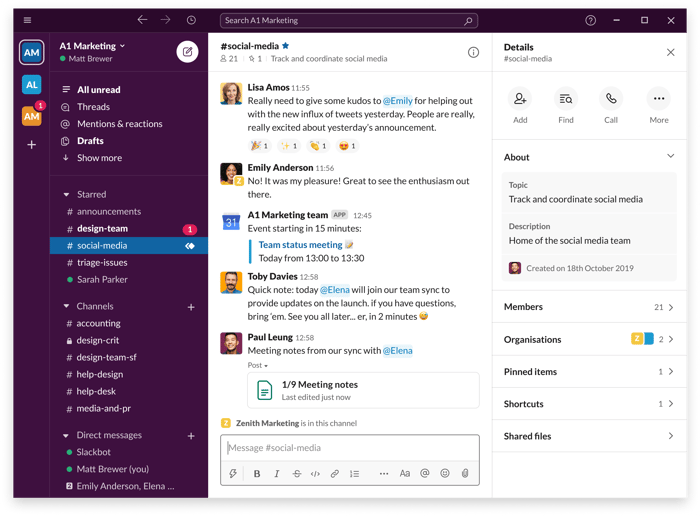This article was originally published on Fool.com. All figures quoted in US dollars unless otherwise stated.
Over the past few years, Slack (NYSE: WORK) attracted millions of users with its streamlined enterprise communication platform, which reduced the need for clumsy email chains and phone calls. Slack's growth led to its direct listing on the NYSE last June, but the stock now trades slightly below its initial reference price of $26.
Investors seemingly lost interest in Slack after Microsoft (NASDAQ: MSFT) aggressively bundled its competing platform, Teams, with its other Office 365 products. Slack's decision to file an antitrust complaint against Microsoft in Europe in July also suggested it was struggling to keep pace with its larger rival.
On its own, Teams doesn't generate significant revenue for Microsoft yet. However, the strength of Microsoft's other businesses lifted its stock nearly 50% over the past 12 months against Slack's 5% gain. Will Microsoft continue to outperform Slack over the next year?
David vs Goliath
Slack's revenue rose 57% to $630 million in fiscal 2020, which ended on Jan. 30, but its generally accepted accounting principles (GAAP) net loss widened from $141 million to $571 million. On a non-GAAP basis, which excludes stock-based compensation and other one-time expenses, its net loss narrowed slightly from $116 million to $113 million.
Microsoft's revenue grew 14% to $143 billion in fiscal 2020, which ended on June 30, and its GAAP net income grew 13% to $44.3 billion. In other words, Microsoft can easily afford to operate Teams at a loss to push Slack out of the market.
Slack's revenue streams
Slack operates a 'freemium' business model in which paid users gain access to unlimited messages, an unlimited number of integrated tools, better security services, and other perks.

Image source: Slack
In the first six months of 2021, Slack's revenue rose 49% year over year to $417.5 million, as the shift to remote work throughout the pandemic boosted demand for its services. Its total number of paid customers grew 30% year over year to 130,000 in the second quarter, with a net dollar retention rate of 125% – which indicates it's squeezing more revenues from its existing customers.
Slack is also gaining ground with larger enterprise customers: Its total number of paid customers with more than $100,000 in annual recurring revenue (ARR) grew 37% during the quarter, and its number of paid customers generating more than $1 million in ARR jumped 78%. Slack Connect, a new platform which allows companies to connect to each other on secure channels, also continued to expand.
Slack's GAAP net loss in the first half of the year narrowed year over year from $393 million to $150 million, and its non-GAAP loss narrowed from $80 million to $16 million. That progress is encouraging, but Slack still expects to remain unprofitable by both measures for the full year.
Microsoft's revenue streams
Microsoft splits its business into three core segments: Productivity and Business Processes, which sells productivity software like Office and Dynamics; the Intelligent Cloud, which includes its cloud platform Azure and server products; and More Personal Computing, which sells its Windows licenses, Xbox games and hardware, and Surface devices.
The pandemic throttled the growth of Microsoft's Productivity and Business Processes unit as businesses shut down, but the growth of its Intelligent Cloud and More Personal Computing units – which benefited from stay-at-home measures boosting usage of cloud services and sales of PCs and gaming consoles – offset that slowdown.
Microsoft also repeatedly highlights the growth of its "commercial cloud" business, which encompasses all its revenue-generating cloud services. Its total commercial cloud revenue rose 36% to over $50 billion, more than a third of its top line, in fiscal 2020 – led by the growth of Azure, the world's second largest cloud infrastructure platform after Amazon Web Services.
The forecasts and valuations
Slack expects its revenue to rise 38% to 39% in fiscal 2021, and for its non-GAAP net loss to narrow. Microsoft hasn't provided any guidance beyond its first quarter yet, but analysts expect its revenue and earnings to rise 10% and 12%, respectively, for the full year.
Slack's stock isn't cheap at 16 times this year's sales, and it's unclear if it can hold Microsoft at bay while narrowing its losses. Microsoft's stock also isn't cheap at just over 30 times forward earnings, but its balanced growth throughout the COVID-19 crisis arguably justifies that premium. Microsoft also pays a forward dividend yield of 1%, while it will likely be years before Slack even considers paying a dividend.
The obvious winner: Microsoft
Based on these facts, it's easy to see why Microsoft outperformed Slack over the past year. Slack is still growing, but it faces intense competitive pressure from Microsoft, it isn't profitable, and its stock is expensive. Therefore, I believe the bulls will remain passionate about Microsoft but indifferent toward Slack over the next year.
This article was originally published on Fool.com. All figures quoted in US dollars unless otherwise stated.








